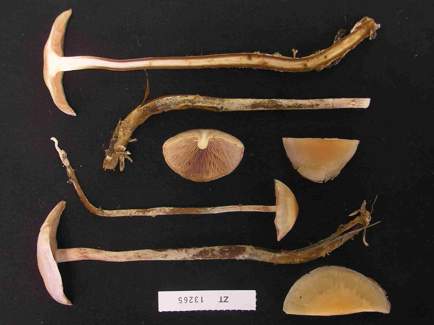 Hebeloma radicans (Photo: E. Horak)
Hebeloma radicans (Photo: E. Horak)Taxonomy
Full name: Hebeloma radicans E. Horak, Beker & U. Eberh., MycoKeys 77: 133 (2021)Genus: Hebeloma
Section: Porphyrospora
Types: MALAYSIA: Johore Bahru, Endau-Rompin National Park, Kahang, Kg. Peta, trail to Kuala Marong (approx. 2.5225°N, 103.3597°E, alt. approx. 50 m a.s.l.) on soil in tropical woodland under Dipterocarpus sp. and Quercus sp., 3 Sep. 2009, E. Horak (Holotype. herbarium acc. no. ZT 13265, KEP FRIM62930, HJB13364).
- arrow_drop_downarrow_drop_upEtymologyFrom ‘radicans’, meaning rooting, to emphasize this character of the species.
- arrow_drop_downarrow_drop_upDiagnosisThe combination of a deeply rooting stipe, about 60 full length lamellae (from stipe to margin of pileus) and spores where almost every spore has a strongly loosening perispore forming a clear layer around the spore, separate this taxon from all other members of H. sect. Porphyrospora, as does the ITS-sequence.
References
Description
- arrow_drop_downarrow_drop_upThresholds
Description of Hebeloma radicans based on 1 collections
- arrow_drop_downarrow_drop_upMacroscopic descriptionPileus: (37) 53 (64) mm diameter; shape convex or broadly umbonate; characters hygrophanous; margin characters smooth; viscosity tacky when moist; colour variation two color; colour at centre often cream or warm buff.
Lamellae: attachment adnate; maximum depth not recorded; number of complete lamellae up to 60; presence of tears absent; white fimbriate edge absent.
Cortina presence: no.
Stipe: (160) 178 (194) x (4) 7 (9) {median} x (4) 7 (9) {basal} mm; stipe Q 21.6–40.0; base shape cylindrical; floccosity fibrillose or pruinose at apex; rooting yes; thick rhizoids at base absent;
Context: Texture firm; stipe interior stuffed; stipe flesh discolouring yes; slenderness measure up to 97.3; smell fruit; taste bitter where recorded.
Spore deposit colour: Not recorded.
Exsiccata characters: hard.
- arrow_drop_downarrow_drop_upMicroscopic descriptionSpores: shape amygdaloid; colour in microscope brown; guttules no. papilla no; Spore Code: O4; P3; D4.
Basidia: 20–28 x 6–7 μm; ave. Q up to 3.4; spore arrangement 4 spored;
Cheilocystidia: main shape balloon-shaped, filiform, pyriform or ventricose; special features observed often mucronate or short; cheilocystidia ratios: A/M = up to 0.66; A/B = up to 0.79; B/M = up to 0.84.
Pleurocystidia: seen.
Ixocutis: epicutis thickness (measured from exsiccata) up to 20 μm; ixocutis hyphae width not recorded; ixocutis hyphae encrustation no; shape of trama elements beneath subcutis angular or isodiametric up to 25 μm wide.
Caulocystidia: Similar to cheilocystidia but larger.
- arrow_drop_downarrow_drop_upSpore measurements
- arrow_drop_downarrow_drop_upCheilocystidia measurements
- arrow_drop_downarrow_drop_upHabitat and distributionHebeloma radicans's preferred habitat appears to be tropical woodland. No associated genera are recorded for the species. No growth habit has been recorded.
According to our current collections, the species is found only in Asia-Tropical. From collector information, it appears collections have been found in the IUCN habitats We map from the collector's description of the habitat to the International Union for Conservation of Nature (IUCN)'s definition using a standardised set of rules. Please see this page for a full list of IUCN habitats.. Within Tropical Asia all our records are from Malesia (Malaysia).
- arrow_drop_downarrow_drop_upCommentaryHebeloma radicans with its vinaceous colored lamellae when mature and the porphyry colored spore print which turns brown with time, is a typical member of Hebeloma sect. Porphyrospora. The highly ornamented and highly dextrinoid spores are often seen in taxa of this section; while the consistently loosening perispore is also a common feature of a number of the taxa within this section, the regularity and presentation of the perispore is atypical and very distinctive. The rooting stipe is also unusual; while we have recorded rooting stipes in other members of this section, namely: H. lactariolens, H. parvisporum, and H. victoriense, in these cases it is a shallow root occurring infrequently and not on every basidiome. The rooting stipe of H. radicans is deep and more reminiscent of H. radicosum. This long rooting stipe should be sufficient to distinguish this species from other described members of this section, but taken together with the spore properties and also the moderately dense (but not crowded) lamellae (approx. 60 full length lamellae), assuming these characters are constant, this taxon is clearly distinct. While, to date, we only have one collection of this species, given its morphological differences and molecular distinctness, we are confident that this taxon is different from any other described within Hebeloma and we hope that its publication will encourage its rediscovery. It is of course possible that it has been confused with other genera, e.g. Psathyrella, as has been the case with other Malay Peninsula collections, but thus far we have not been able to find any evidence of this.
Geographic distribution
Phenology
- arrow_drop_downarrow_drop_upAdditional cited collections